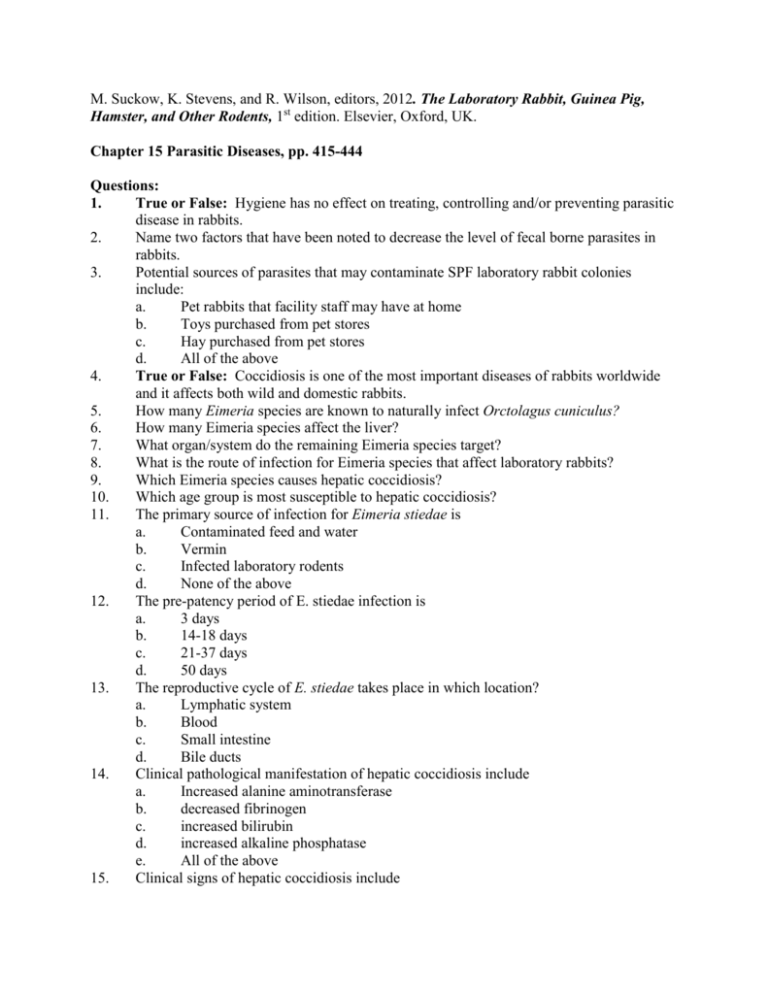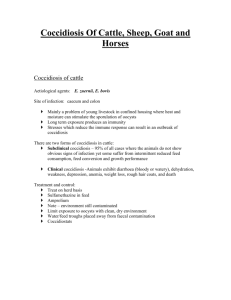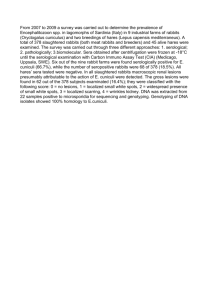Chapter 15: Parasitic Diseases Rabbit
advertisement

M. Suckow, K. Stevens, and R. Wilson, editors, 2012. The Laboratory Rabbit, Guinea Pig, Hamster, and Other Rodents, 1st edition. Elsevier, Oxford, UK. Chapter 15 Parasitic Diseases, pp. 415-444 Questions: 1. True or False: Hygiene has no effect on treating, controlling and/or preventing parasitic disease in rabbits. 2. Name two factors that have been noted to decrease the level of fecal borne parasites in rabbits. 3. Potential sources of parasites that may contaminate SPF laboratory rabbit colonies include: a. Pet rabbits that facility staff may have at home b. Toys purchased from pet stores c. Hay purchased from pet stores d. All of the above 4. True or False: Coccidiosis is one of the most important diseases of rabbits worldwide and it affects both wild and domestic rabbits. 5. How many Eimeria species are known to naturally infect Orctolagus cuniculus? 6. How many Eimeria species affect the liver? 7. What organ/system do the remaining Eimeria species target? 8. What is the route of infection for Eimeria species that affect laboratory rabbits? 9. Which Eimeria species causes hepatic coccidiosis? 10. Which age group is most susceptible to hepatic coccidiosis? 11. The primary source of infection for Eimeria stiedae is a. Contaminated feed and water b. Vermin c. Infected laboratory rodents d. None of the above 12. The pre-patency period of E. stiedae infection is a. 3 days b. 14-18 days c. 21-37 days d. 50 days 13. The reproductive cycle of E. stiedae takes place in which location? a. Lymphatic system b. Blood c. Small intestine d. Bile ducts 14. Clinical pathological manifestation of hepatic coccidiosis include a. Increased alanine aminotransferase b. decreased fibrinogen c. increased bilirubin d. increased alkaline phosphatase e. All of the above 15. Clinical signs of hepatic coccidiosis include 16. 17. 18. 19. 20. 21. 22. 23. 24. 25. 26. a. Anorexia and wasting b. pot belly appearance c. icterus d. All of the above Pathologic and histopathologic lesions associated with hepatic coccidiosis include a. diffuse, multifocal white nodules on the surface b. enlarged liver, gall bladder, and bile duct c. hyperplasia and cystic enlargement of the bile duct epithelium d. Inflammatory cell infiltration around bile ducts e. All of the above True or False: E. stiedae organisms are rarely found in the liver on histopathology or impression smears. True or False: Secondary bacterial infections may result from E. stiedae primary infection. Disease pathogenesis is due to a. Infection of bile duct epithelial cells b. Inflammatory reactions in the bile ducts c. Obstructive jaundice due to oocyst shedding d. All of the above Diagnosis of hepatic coccidiosis is by a. Identification of oocysts by fecal examination b. Identification of oocysts in bile duct aspirates c. Antibody detection in serum d. All of the above Treatment options for hepatic coccidiosis include a. Robenidine mixed in the feed b. Sulfamethoxine mixed in the feed c. Lasalocid or monensin mixed in the feed d. All of the above True or False: Intestinal coccidia species vary greatly in pathogenicity. The most common intestinal coccidian species for laboratory rabbits is a. E. stiedae b. E. perforans c. E. intestinalis d. E. exigua True or False: Coinfection with two or more coccidian species is common. Speciation of Eimeria species causing intestinal infection in laboratory rabbits is performed by a. Examining sporulated oocysts obtained from feces or intestinal contents b. Identifying morphologic characteristics c. Evaluating genomic profiles d. Considering the area of intestine affected e. All of the above True or False: Adult carriers of intestinal coccidian serve as a source of infection for newborn rabbits. 27. 28. 29. 30. 31. 32. 33. 34. 35. 35. 36. 37. 38. The severity of clinical disease due to intestinal coccidiosis depends on several factors, including: a. The species of Eimeria causing disease b. The amount of infective agent present c. The susceptibility of the animal d. All of the above Clinical signs of intestinal coccidiosis include a. Diarrhea, rough coat, anorexia and weight loss b. Abdominal enlargement, icterus c. Head tilt, vocalization d. All of the above True or False: Death can occur within a few days of clinical onset of disease. Diarrhea resulting from intestinal coccidiosis can be characterized as a. Watery b. Containing blood and mucous c. Foul smelling d. All of the above Microscopic lesions of intestinal coccidiosis include a. villous atrophy, cellular congestion and edema b. epithelial necrosis and leukocytic exudates c. A and B d. None of the above True or False: Oocysts undergo sporogony and become infective within the intestine after ingestion. True or False: Rabbits that survive intestinal coccidiosis develop active immunity and become asymptomatic carriers. True or False: Immunity to intestinal coccidian can be passively transferred from dam to offspring. Which samples should be examined to diagnose intestinal coccidiosis? a. fecal preparations b. Intestinal preparations, including histologic samples c. Both feces and intestinal samples d. Blood True or False: Cryptosporidium species invade intestinal cells and reside in the cytoplasm similar to coccidian. Infection with Cryptosporidium species can occur from a. Ingestion of oocysts contaminating the environment b. Autoinfection c. Aerosol transmission d. A and B True or False: Most infections with Cryptosporidium spp. result in no clinical signs. Diagnostic methods for Cryptosporidium infection include a. Examination of direct fecal smears b. Examination of fecal flotations using concentrated sucrose c. ELISA or PCR d. Histologic examination of intestines 39. 40. 41. 42. 43. 44. 45. 46. 47. 48. 49. 50. 51. 52. 53. 54. e. B, C, and D True or False: Rabbits serve as a model for ocular toxoplasmosis, a disease seen in immunodeficient humans. Recognized zoonotic agents that can occur in laboratory rabbits include a. Cryptosporidum spp. b. Toxoplasma gondii c. Eimeria stiedae d. A and B Clinical signs of acute toxoplasmosis include a. Fever greater than 104°F b. Increased respirations c. Ocular and Nasal Discharges d. All of the above True or False: Pathologic lesions associated with Toxoplasmosis are restricted to the CNS. True or False: Toxoplasmosis can be diagnosed in laboratory rabbits from identification of oocysts in feces. True or False: Cats can serve as a source of Toxoplama gondii for laboratory rabbits. Infection with Encephalitozoon cuniculi occurs by a. Fecal oral route b. Ingestion of mature spores from urine c. Aerosol transmission d. Skin penetration True or False: When clinical signs occur in acute disease, symptoms of renal disease. The classic pathologic lesion seen in encephalitozoonosis is a. pyogranulomatous encephalitis affecting the cerebrum b. pyogranulomatous nephritis c. Intestinal villus atrophy d. None of the above True or False: Diagnosis of encephalitozoonosis is generally by serologic methods. Psoroptes cuniculi is a. non-burrowing ectoparasite, commonly known as a mite b. Found primarily on the inner surface of the pinnae c. Feed on tissue fluids from the host d. All of the above Clinical signs of mite infestation can include a. Exudate buildup on the inner surface of the ear b. Inflammation of the inner surface of the ear c. odorous and painful ears d. all of the above True or False: Diagnosis can be made by direct visualization of adult mites in the ear or microscopic examination of exudate. What is the most commonly identified fur mites affecting rabbits? What is the main clinical sign of fur mite infection in rabbits? True or False: Treatments, such as ivermectin, imidocloprid, and selamectin are effective against multiple species of ectoparasites including mites, lice and fleas. 55. 56. 57. 58. 59. 60. True or False: Rabbits can be aberrant hosts for the dog heartworm Dirofilaria immitis. What is the most common pinworm found in rabbits in the US? Treatment and control of pinworm infections should include a. Treatment with an anthelminthic, such as fenbendazole or ivermectin b. Cleaning the perianal area of rabbits at the initiation of treatment c. Thorough decontamination of the environment d. All of the above Which nematode is the main causative agent of visceral larval migrans in rabbits? Which tapeworm infects rabbits as an intermediate host? Which trematode infection have rabbits been used for as a model of host response? Answers: 1. False 2. The use of non-solid flooring housing and proper sanitation. 3. D 4. True 5. Eleven 6. One 7. The intestinal tract 8. Fecal-oral 9. Eimeria stiedae 10. Young animals around weaning age 11. A 12. B 13. D 14. E 15. D 16. E 17. False 18. True 19. D 20. D 21. D 22. True 23. B 24. True 25. E 26. True 27. D 28. A 29. True 30. D 31. C 32. False 33. True 34. False 34. 35. 36. 37. 38. 39. 40. 41. 42. 43. 44. 45. 46. 47. 48. 49. 50. 51. 52. 53. 54. 55. 56. 57. 58. 59. 60. C False D True E True D D False False True B False A True D D True Cheyletiella parasitovorax Excessive flakes on the skin, particularly in the scapular area True True Passalurus (Oxyuris) ambiguous D Baylisascaris procyonis Taenia pisiformis Fasciola hepatica






